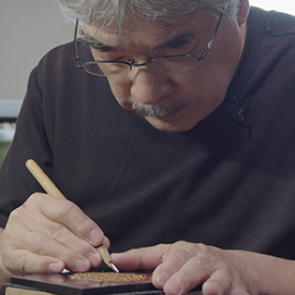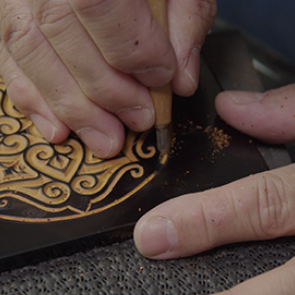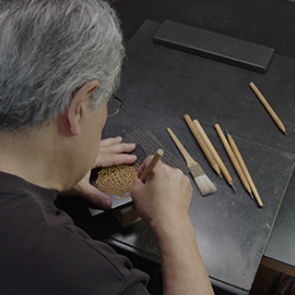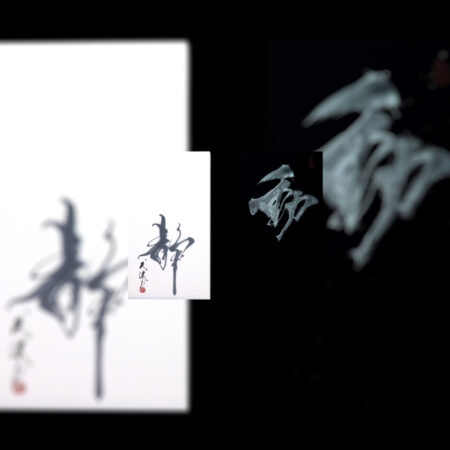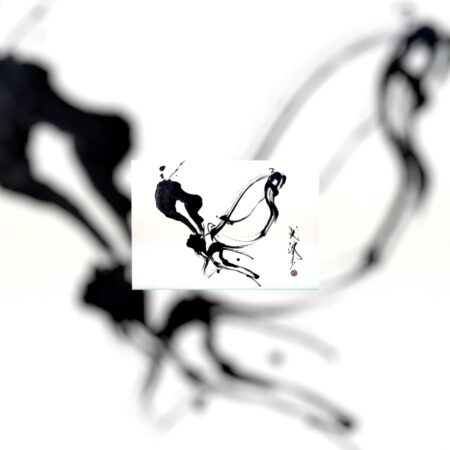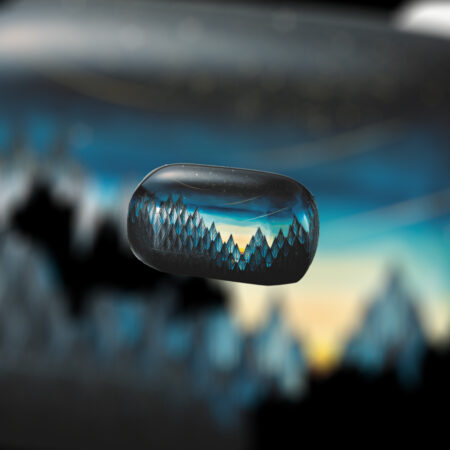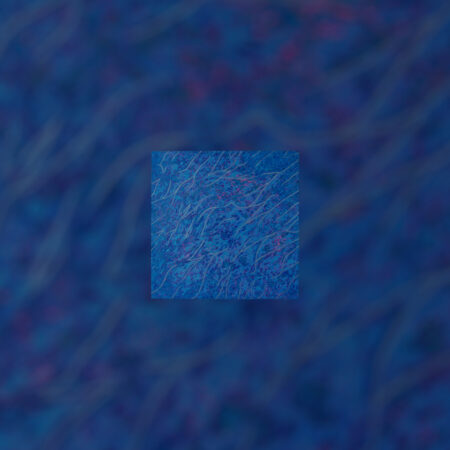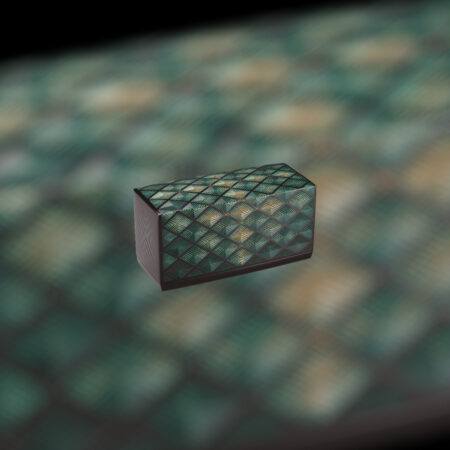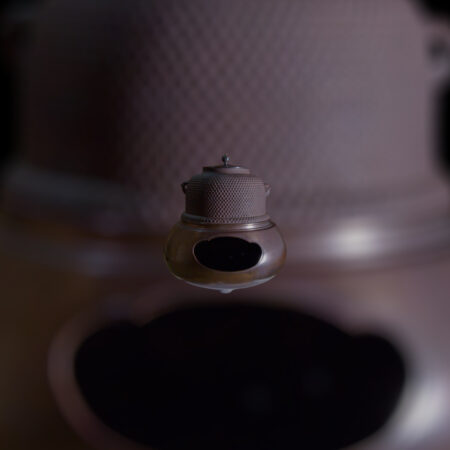This work utilizes the "choshitsu" technique, the most time and effort-consuming oriental lacquer technique since ancient times, in which dozens of color coatings are applied over a bare surface, which is then precisely carved. It was originally a Chinese technique, developed in Japan in the Kamakura period (1185-1333) as karamono lacquerware. It was much valued as a kind of Buddhist ritual utensil
and tea ceremony tool.
It's a small vessel with a flat mouth, coming with a lid. It's a representation of a small world with "dawn" that heralds the beginning of the day. It is a carved lacquer work like a microcosm, with a unique, one-and-only floral, geometric pattern. The stars remain in the sky at dawn, the forest landscape is tinted with morning glow, and the fresh morning air simply embraces us...such an epic morning scene in the mountains is revealed by the discernible lacquer carving techniques.
In the order of yellow to vermilion then yellow, white to blue then black, one layer of paint covers the other with over 50 layers in total. A specialized carving knife is used for the detailed patterns, which are then sharpened. The base is made of dry lacquer. The side of the piece, where forest trees overlap one another, is carved with a series of linear patterns, and the depth of the carving expresses the mysterious
atmosphere of the forest with shades of various colors. The artist used "chinkin dots" engraving and pearls to illustrate the starry night sky.
He is a big fan (and creator) of ground patterns from older times, and
this work is an illustration of his interest. The theme of this work is "Dawn", it is his favorite time of day indeed.
Art
Carved Lacquer Box "Ripples"
Expresses the scene of wave crests illuminated by the sunset.
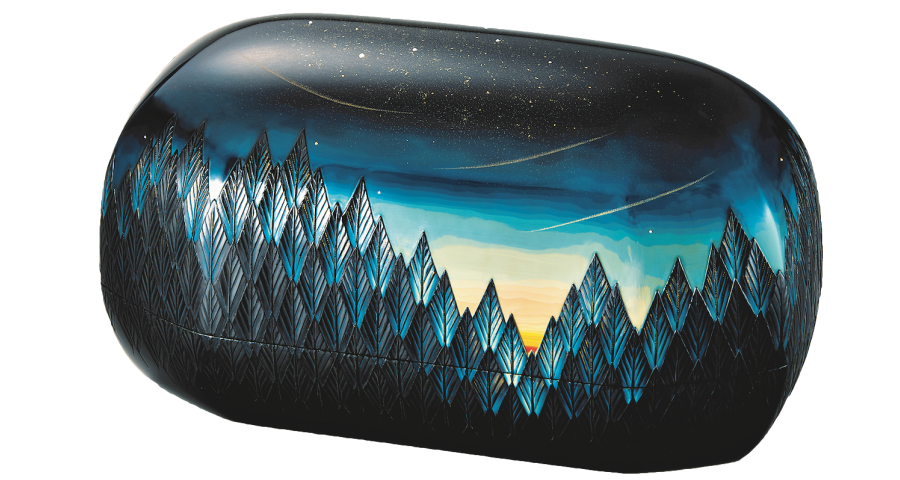
Artist
Works on cultural property rescue both domestically and internationally.
Tatsuya Matsumoto
松本 達弥
A lacquerware artist specializing in carved lacquer.
He trained under Kodo Otomaru (1898–1997), a native of Kagawa Prefecture who was nationally designated as a Holder of Important Intangible Cultural Property (so-called Living National Treasure) due to his achievement in carved lacquer.
He expresses the original design/pattern expressions of carved lacquer as the beauty of form instead of the beauty of use. Rescuing Japanese cultural assets inside and outside Japan, he has been restoring lacquerware valued as cultural assets. He has created a number of works featuring a wide range of designs including realistic expression such as botanical designs, abstract expression using geometric patterns, and expression using saihi designs (guri (curvilinear patterns) carved on layered urushi lacquer coatings of different colors).
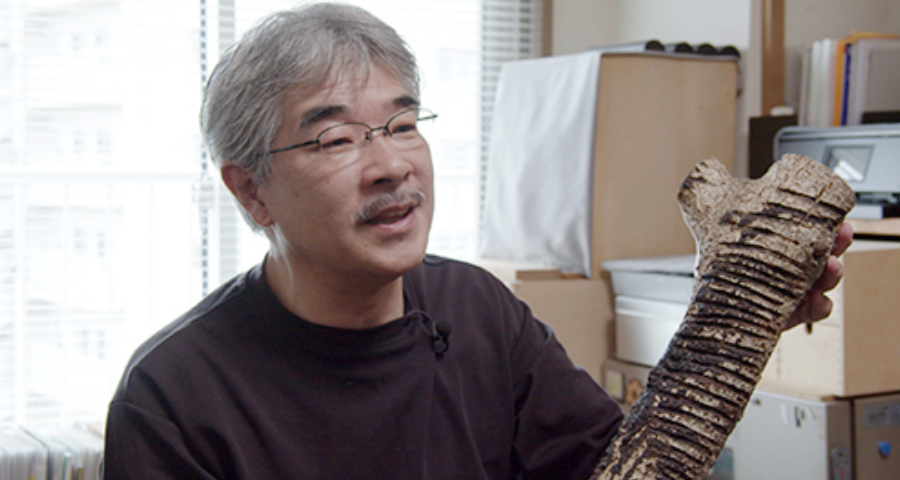
Art Style
Crafting for millennia to come.
Lacquer Art
Lacquer art refers to the techniques for creating works by coating objects with natural lacquer and then drawing designs/patterns on the surface. A drop of sap from the lacquer tree is the basic material of lacquerware. Lacquer trees, which grow only in Southeast Asia, provide a wonderful coating agent. As lacquer creates a decay-free film and repels water when it solidifies, it has been used for daily life tools since ancient times. Leveraging the characteristics of lacquer for exquisitely decorating items with gold, silver, and seashells, red lacquer and black lacquer have been used for musical instruments and boxes for storing important documents and clothing, as well as the helmets, armors, and weapons of samurai warriors. Today, splendid lacquerware works are being created including tea ceremony tools (e.g., tea containers called natsume, incense burners) and decorative boxes, in addition to bowls, trays and other daily life items. With 500 years of history, Japanese lacquerware can be found around the world.
Creating unique works, Tatsuya Matsumoto has been pursuing expressions using saihi.
Saihi is one type of guri designs that were crafted in China during the era of the Song dynasty. Saihi works are often created by layering multiple coatings of yellow, red, or other colored lacquer alternately and then applying a final coating of black or dark brown lacquer. The designs feature abstract curvilinear patterns. Introduced to Japan around the 13th or 14th century as Chinese lacquerware, about a dozen lacquerware with saihi designs from that time remain in Japan. They are extremely precious as hardly any saihi lacquerware from back then remain in China. The refined arrangement of the curvilinear patterns and the delicate and accurate carving techniques of those works make it absolutely hard to believe that the techniques are about 1,000 years old.
Matsumoto continues to create vigorously while hoping that his works will still be catching people’s eyes and used by them thousands of years from now.
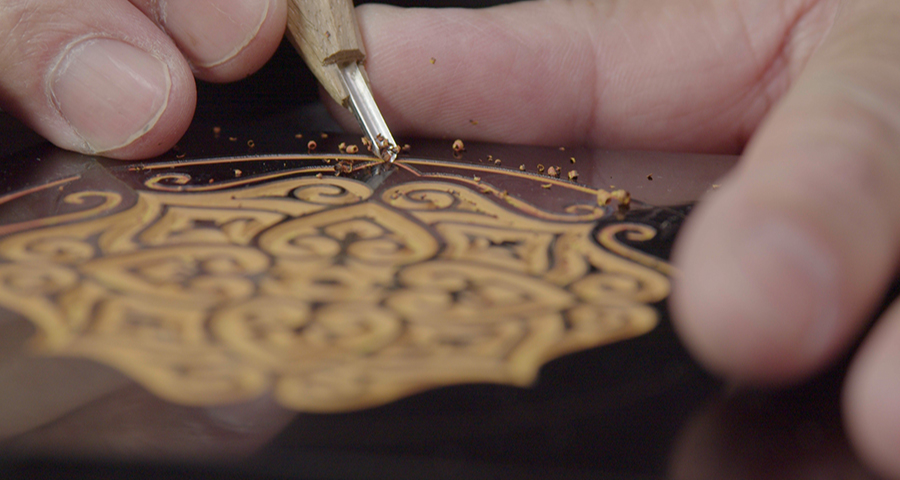
Roots
Carving reveals patterns in vibrant layers.
One of the lacquerware decoration techniques, carved lacquer is said to have originated in China about 1,200 years ago during the era of the Tang dynasty. It was introduced to Japan by Zen Buddhist monks. Those made solely of layered red lacquer coatings are called tsushu and those made solely of layered black lacquer coatings are called tsuikoku. With the development of pigments, a variety of colored lacquer is used in carved lacquer today.
Starting out by envisioning the completed work, a thick layer of lacquer is created by layering coatings of black, red, yellow, green, or other colored lacquer a few dozen times, sometimes more than 100 times. This multiple-colored layer of lacquer coatings is carved to create three-dimensional patterns/designs. By carving down the surface to the desired color layer, the buried lacquer color is revealed and artistic pictorial patterns are created. As the layer of multiple lacquer coatings is thick, three-dimensional, voluminous patterns and designs are carved out. The surface has a smooth gloss appearance unique to lacquer.
